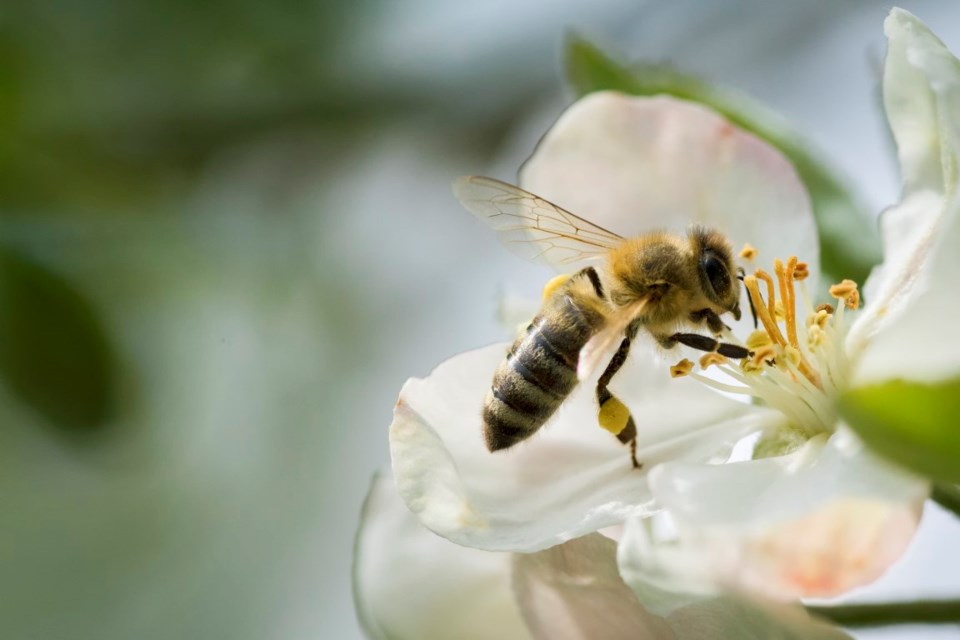WESTERN PRODUCER — Researchers determine that a common treatment for fire blight in fruit orchards can hurt the pollinator’s foraging ability
In recent years, the use of streptomycin antibiotic spray has increased as orchard farmers fight a rise in plant bacterial infections caused by pathogens such as Erwinia amylovora.
Fire blight can turn blossoms and shoots of apple and pear trees black, making them look like they were scorched by fire. Citrus greening, also known as yellow dragon disease, turns citrus fruits green, bitter, and unusable. As a result, millions of acres of crops have been devastated by these diseases across North America and around the world.
To complicate matters, streptomycin resistance has been detected in the pathogen across regions of Canada and the United States.
But just as pests adapt to the antibiotic spray, beneficial pollinators such as bumblebees are adversely affected. Researchers at Emory University in Atlanta, Georgia, have found that exposure to upper limit dietary streptomycin decreases a bee’s foraging choice accuracy and increases its avoidance behaviour.
There is increasing evidence that suggests insect gut microbiomes play a role in learning and behaviour, which are essential for the survival of pollinators and their pollination efficiency, but which could be disrupted by antibiotic exposure.
Berry Brosi, associate professor in the department of biology at the University of Washington, said there has been work in other insects, like fruit flies, that suggests there is a “gut-brain axis” that aid insect learning, cognition, and behaviour.
“Interestingly, there is also evidence of some relationship in humans, mice, and other mammals, but perhaps not as strong as in insects, which have relatively simple nervous systems compared to mammals,” he said.
“The antibiotic part came in from reading about the use of antibiotics to manage bacterial diseases in citrus orchards. With the connection between learning/cognition/behaviour and insect microbiomes, (co-lead author of the paper Laura Avila) wondered if these agricultural practices could impact bee learning and behaviour.”
The researchers conducted experiments with managed bumblebees to test the effects of an upper-limit dietary exposure to streptomycin. The work took place between spring 2019 and fall 2020.
“No one has examined the potential impacts on pollinators of broadcast spraying of antibiotics in agriculture, despite their widespread use,” said Avila, post-doctoral fellow in the department of biology at Emory University.
Brosi said the research is a first step toward understanding whether the use of streptomycin on food crops is taking a toll on beneficial pollinators.
“We used a laboratory foraging chamber for this work,” he said. “It uses artificial flowers a bit like small hummingbird feeders but sized for bees. They are computer controlled and built around a radio-frequency identification reader (RFID). They dispense a nectar reward when a bee with a tiny RFID tag enters the flower.”
He said that the tags had unique identifiers so they could track which bee went to which flower, when they went there, and how long they were in each flower.
“The system has a lot of power for understanding the choices bees make between flowers.”
In a separate test, half the bees were fed on plain sucrose, or sugar water, to simulate nectar. The other half were fed on sucrose dosed with streptomycin. After two days on the diet, the bees were presented with different coloured cardboard strips, yellow and blue. One colour was saturated with plain water and the other was saturated with sucrose.
“You can train bees to distinguish between different rewards based on associations with colour. We trained each bee with two coloured cardboard strips. We made sure they had multiple opportunities to “taste” each with their tongue (proboscis) or with their antennae. Then we collected data after the training and recorded the percentage of bees that went for the sugar water as opposed to the plain water.
“In a nutshell, the control bees (fed plain water) overwhelmingly went for the sugar water (close to 90 percent of the control bees made that choice). By contrast, the antibiotic-exposed bees only chose the sugar water about half the time. Statistically, this was a large and significant difference.”
In addition, the antibiotic-treated bees were more likely to display avoidance behaviour toward the stimuli in the experiments.
Based on evidence from the laboratory work, researchers hypothesize that the observed negative impact of streptomycin on bumblebees may be due to the disruption of the insects’ microbiome.
Brosi said that there is a “gut-brain axis” in many animals whereby microbes in the gut create biochemical signals that are then transmitted back to the brain, often after some modulation.
What is still unknown is how long streptomycin remains active in the field.
Brosi said that they do not know the residual concentrations of antibiotics on crop flowers and their dynamics are not known in terms of effects on pollinators. What is known is that warmer springs can increase bacterial disease pressure, forcing growers to spray multiple times while an orchard is in bloom. As part of their ongoing field work, the researchers have discussed the study with orchard growers.
“Generally, growers value pollination services and want to understand if crop management practices can impact bee health,” said Brosi. “Many are curious about how well alternatives to antibiotics work but are also understandably concerned about the cost of these alternatives.”
Brosi said he was surprised at how strong an effect the streptomycin had on the study bees in the experiments.
Future research is expected to see if the effects observed in the lab can be observed in the field where there is more variation in terms of exposure and a more complex cognitive environment for bees to navigate.
The research was published in the Proceedings of the Royal Society B: Biological Sciences.

